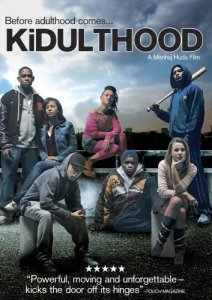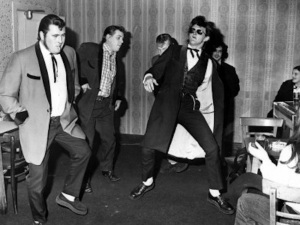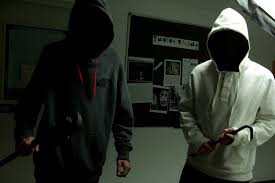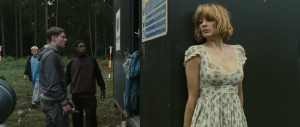One of the more interesting parts of writing my dissertation so far has been investigating the phenomenon of the British hoodie. My dissertation focuses on the post-2000 British horror resurgence, and the hoodie horror cycle has been one of the more prolific cycles within the more general boom.

Menhaj Huda’s 2006 film Kidulthood is often identified as one of the first hoodie films.
Hoodies are usually working-class teen delinquents who wear hooded sweatshirts. During the first decade of the 2000s, hoodies became prevalent in a variety of forms of British popular culture. There were frequent news stories citing hoodies as a consequence and contributor to “Broken Britain,” a cultural discourse that maintains that Britain is more lawless, chaotic, and dangerous than ever before. Cinemas screened films like Kidulthood (Menhaj Huda, 2006) and Harry Brown (Daniel Barber, 2009), while various television channels produced and aired programs like Misfits (2009-2013, E4) and the reality series Kick Ass Kung Fu (2013, Sky1 HD), wherein a Shaolin monk trained hoodie-clad teens from “bad areas” to channel their aggression and stop being “rude waste[s] of space,” as one of the show’s hoodies put it. Even Piers Morgan produced and directed a documentary on hoodies for Sky1, Hoodies Attack (2005). At least one London gym began offering a much-publicized “Chav Fighting” class wherein middle class customers could learn to put the world to rights, while the Thames Valley Police had their officers swap their uniforms for hoodies and tracksuit pants in an attempt to blend in and stop anti-social behavior (though the officers did not wear baseball caps, which were thought to make them look “too American”).
Like the Teddy Boys, punk rockers, and, most recently, the club kid ravers, hoodies are set apart from so-called normal society. The Teddy Boys’ association with the rise of American rock and roll, and their reported rioting and dancing in theaters’ aisles during screenings of Blackboard Jungle (Richard Brooks, 1955), positioned them as importing the dangerous violence of American teens via the bad influence of American rock and roll. In particular, their sartorial borrowings from the African-American community set out their cultural borrowings as dangerous not only because of their Americanized nature, but because of their origins in communities of color.

Source: Flashbak
Hoodies are set apart by their mode of dress (face-obscuring hooded sweatshirts), their musical preferences (most often assumed to be rap and hip-hop), and an anti-authoritarian attitude that sometimes places them on the wrong side of the law. And, much like the moral panic surrounding the Teddy Boys in the 1950s, fear of hoodies belies not only a fear and distrust of young people but a fear of the Americanization of British culture.

Still from Johannes Roberts’s hoodie horror film F (2010)
Hoodie teens are seen as having brought American gang culture, as promulgated by American rap and hip hop and American films, to the streets of the UK. In particular, the UK garage music scene was seen as, in the words of political and social commentator Deborah Orr, a “bad-seed” offshoot of UK youth culture that is heavily influenced by US gangsta rap culture (or at least seen by middle class commentators as heavily influenced by gangsta rap). Of course, UK garage music, because of its perceived links to US gangsta rap culture, made an easy scapegoat, and condemning UK garage for promoting violence was a way to more implicitly condemn the working class urban populations and racial and ethnic minorities who listened to UK garage.
Hoodie horror films often signal this link between hoodies and Americanization through rap-heavy soundtracks or having the evil hoodies listen to or perform rap in the diegesis. For example, in James Watkin’s Eden Lake (2008), the hoodie gang brings a boom box to the beach and plays rap music; this music plays at a lower level of the sound hierarchy, just loud enough to act as a menacing, unintelligible buzz that haunts the scene and foreshadows their coming attack on the middle class protagonists Jenny and Steve.

The imagery of hoodie horror mirrors the aural distinctions between the Americanized hoodies and their respectable victims. In this image, the trailer serves as a clear visual delineation of the line between acceptable, middle-classness, as represented by Jenny on the right, and the film’s villains, on the left: the unacceptable, Americanized, working-class hoodies who antagonize and torture Jenny and her boyfriend throughout the film.
These links to Americanization make it even easier for the media (as well as some filmmakers and audiences) to Other hoodies; they are not only working-class and young, but they can be seen as more influenced by American and Americanized culture than respectable middle-class Brits. Of course, this Othering places an additional mark upon hoodies of color, who are already also Othered by their racial and/or ethnic status.
Lindsey Decker is a fifth-year Ph.D. candidate studying Film and Television in the Department of English. Her dissertation examines questions of transnational cinema in self-reflexive British horror films.
